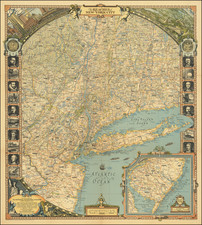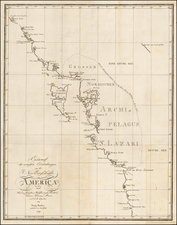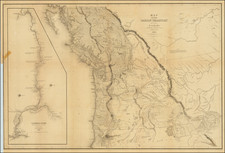A rare and immensely significant map of the Iroquois Country, prefiguring more than a century of conflict for command of northeastern North America. Offered in partnership with Boston Rare Maps.
This map illustrates a pivotal moment in the history of Canada, just after the French crown had assumed control of the colony and was in the process of stabilizing it for further settlement.
While inter-European conflict would come to characterize the 18th-century colonization of North America, French efforts to settle Canada in the 17th century were largely thwarted by Native resistance. Indeed, it was harassment by the Iroquois that led to the collapse of the Compagnie des Cent-Associés and the establishment of New France as a colony controlled by the French state, in 1663. This map is concerned with the events that immediately followed that; namely, the arrival of the Carignan-Salières Regiment, the identification and location of the belligerent Iroquois nations, their pacification by French forces, and the opening up of New France to further exploration and settlement. After the Iroquois nations were conquered, the French were free to explore west of the St. Lawrence, with Pierre-Esprit Radisson and Medard Chouart, sieur de Groseilliers, reaching as far as Lake Superior.
The map features three forts along the Richelieu River, with large-scale plans of each occupying the vast empty space north and west of Lake Ontario. The forts are a testament to French efforts to bring the hostile Iroquois to heel, and while they were actually located in a small area at the top right of the map, their securing influence was cast over all of the territory north and west of Lake Ontario.
This is the first generally accurate map of Lake Champlain and its relationship with the Hudson River. The map’s depiction of the vital Richelieu River-Lake Champlain-Lake George-Hudson River corridor, soon to become known as “The Great Warpath”, is properly rendered here for the first time. The pieces of this puzzle had of course been mapped earlier, most famously in Champlain’s capstone map of 1632 and in the so-called “Jansson-Visscher” series, but in these earlier maps the elements are misaligned – with Lake Champlain pointing to the Connecticut River, rather than the Hudson.
This extraordinary map is the first to focus on the Iroquois Country at a large scale. It depicts the roughly triangular region bounded on the North and West by the St. Lawrence River, on the East by the Hudson River-Lake Champlain-Richelieu River corridor, and on the south by the villages of “Les Cinq Nations Iroquoises.” French settlements along the St. Lawrence are identified, as is the Anglo-Dutch presence at “Manata” (Manhattan) and “fort Dorange” (Albany) along the Hudson. The settlements of the Five Nations are shown rather schematically in a rough line extending from the Mohawk River just west of Albany to the far reaches of Lake Ontario.
The geography of the map is also groundbreaking, for it is the first to come close to piecing together the relationship of the St. Lawrence River-Lake Ontario corridor to the Mohawk Valley. This soon became vital as English settlement advanced in the Province of New York, and settlers began to bump up against the Five Nations and the French.
François Joseph le Mercier, New France and the Iroquois
This map was prepared for the report of François Joseph le Mercier (1604-1690), Superior General of the Jesuit missions in New France. Le Mercier was first posted to New France in 1635 and served for some years on missions to the Huron. In 1653 he was appointed Superior General as well as Rector of the Jesuit College in Quebec. He served in the former role from 1653-56 and again from 1665-70, during which time he wrote the annual reports that are now counted among the Jesuit Relations. He must have been both brave and durable, for in 1656-57, in spite of his seniority, he devolved authority to a vice-superior and undertook a dangerous mission to the Onondaga. After a brief return to France in 1673, he was sent to the West Indies, where he rose to Superior-General of the missions there before dying in Martinique in 1690.
The map was used to illustrate the events described in Le Mercier’s Relation de ce qvi s’est passé en la Novvelle France, és années 1664. & 1665. The Relation describes events following the June 1665 arrival in Quebec of Alexandre de Prouville, Marquis de Tracy, who in 1663 had been appointed Governor-General of the French Americas. One of the Marquis’ objectives was to pacify the hostile Iroquois, in particular the Mohawks who engaged in regular raids on New France via Lake Champlain and the Richelieu River. “His vigorous and resolute measures against the Mohawks brought peace to the harassed Canadian colonies, and so alarmed the savages that they did not again venture to disturb the French settlers, for years afterward.” (Reuben Gold Thwaites, ed., The Jesuit Relations and Allied Documents[:] Travels and Explorations of the Jesuit Missionaries in New France[:] 1610-1791, p. 161 note 11)
Le Mercier’s Relation describes how at the end of July 1665 de Tracy sent an advance force of four companies of the Regiment Carignan-Salieres on an expedition down the Richelieu River:
“The purpose in view in this first campaign was to erect along the route certain forts, which were deemed absolutely necessary, both for maintaining open communication and the freedom of traffic, and also for serving as magazines for the troops, and places of refuge for sick and wounded soldiers.” (Chap. IV, pp. 42-43)
This advance force succeeded in constructing three forts along the Richelieu River: Fort Richelieu, Fort St. Louis and Fort St. Theresa. Each is shown on the map in its proper location, with larger plans occupying the open space north and west of Lake Ontario.
Le Mercier goes on to sketch the Five Nations of the Iroquois. He moves from East to West, beginning with the “Anniegué” (Mohawk) near Albany and ending with the “Sonnontuan” (Seneca) near the far end of Lake Ontario. The Anniegué, Onneiout (Oneida) and Onnontagué (Onondaga) are described as hostile, while the western nations of Sonnontuan and Oiogoiuen (Cayuga) are viewed as neutral and, at least in case of the Oiogoiuen, partially converted. The narrative account is complemented by the map, which which shows the location of each of the Five Nations along the Mohawk Valley or south of Lake Ontario.
Lake Ontario dominates the map, and French territorial ambitions are highlighted by Le Mercier’s account:
“the lake, which appears like a sea, without Islands and without shores, on which barks and ships can sail from one end to the other in perfect safety. Hence communication would be easy between all the French Colonies that could be planted on the shores of this great lake, which is more than a hundred leagues long by thirty or forty wide.” (Chap. V, p. 54)
In all, a rare and vital piece of 17th-century cartographic Americana, reflecting both important advances in geographical knowledge and documenting the clash of civilizations in northeastern North America.
Rarity and references
We find no record of the map having appeared on the antiquarian map market. However the Siebert copy of the Relation, with the map, sold for $31,050 in 1999 and was sold again for $31,800 in 2001. Prior to that, Rare Book Hub notes only two copies of the Relation, both sold in 1965, one being the Streeter copy and both with the map.










![[New England] Tierra Nueva](https://storage.googleapis.com/raremaps/img/small/64626.jpg)



![[ Tribeca Indenture ] 1790 Indenture Between Robert C. Livingston and Amos Laforgee For Lease of Property on Reade Street in New York City](https://storage.googleapis.com/raremaps/img/small/100514.jpg)